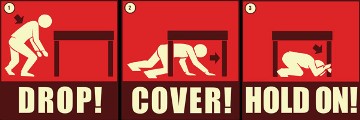Protect Yourself During Earthquake Shaking!

Learn what to do during an earthquake, whether you’re at home, work or school. Taking the proper actions, such as “Drop, Cover, and Hold On”, can save lives and reduce your risk of death and injury. During earthquakes, drop to the floor, take cover under a sturdy desk or table, and hold on to it firmly. Be prepared to move with it until the shaking stops. The area near the exterior walls of a building is the most dangerous place to be. Windows, facades and architectural details are often the first parts of the building to collapse. To stay away from this danger zone, stay inside if you are inside and outside if you are outside.
DO NOT Head for the Doorway
An enduring earthquake image of is a collapsed home with the door frame as the only standing part. From this came our belief that a doorway is the safest place to be during an earthquake. True—if you live in an old, un-reinforced house. In modern houses, doorways are no stronger than any other part of the house. You are safer taking cover under a sturdy table or desk.
If you are…
Indoors: Drop, cover, and hold on. During earthquakes, drop to the floor, take cover under a sturdy desk or table, and hold on to it firmly. Be prepared to move with it until the shaking stops. If you are not near a desk or table, drop to the floor against the interior wall and protect your head and neck with your arms. Avoid exterior walls, windows, hanging objects, mirrors, tall furniture, large appliances, and kitchen cabinets with heavy objects or glass. Do not go outside!
In bed: If you are in bed, hold on and stay there, protecting your head with a pillow. You are less likely to be injured staying where you are. Broken glass on the floor has caused injury to those who have rolled to the floor or tried to get to doorways.
In a high-rise: Drop, cover, and hold on. Avoid windows and other hazards. Do not use elevators. Do not be surprised if sprinkler systems or fire alarms activate.
Outdoors: Move to a clear area if you can safely do so; avoid power lines, trees, signs, buildings, vehicles, and other hazards.
Driving: Pull over to the side of the road, stop, and set the parking brake. Avoid overpasses, ridges, power lines, signs and other hazards. Stay inside the vehicle until the shaking is over. If a power line falls on the car, stay inside until a trained person removes the wire.
In a stadium or theater: Stay at your seat and protect your head and neck with your arms. Don’t try to leave until the shaking is over. Then walk out slowly watching for anything that could fall in the aftershocks.
Adapted from Putting Down Roots in Earthquake Country, published by the Southern California Earthquake Center and available online at www.earthquakecountry.info/roots .